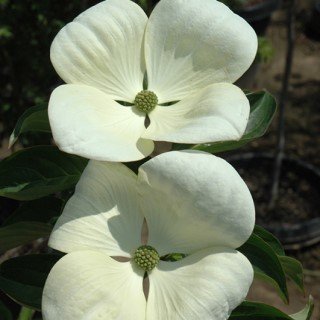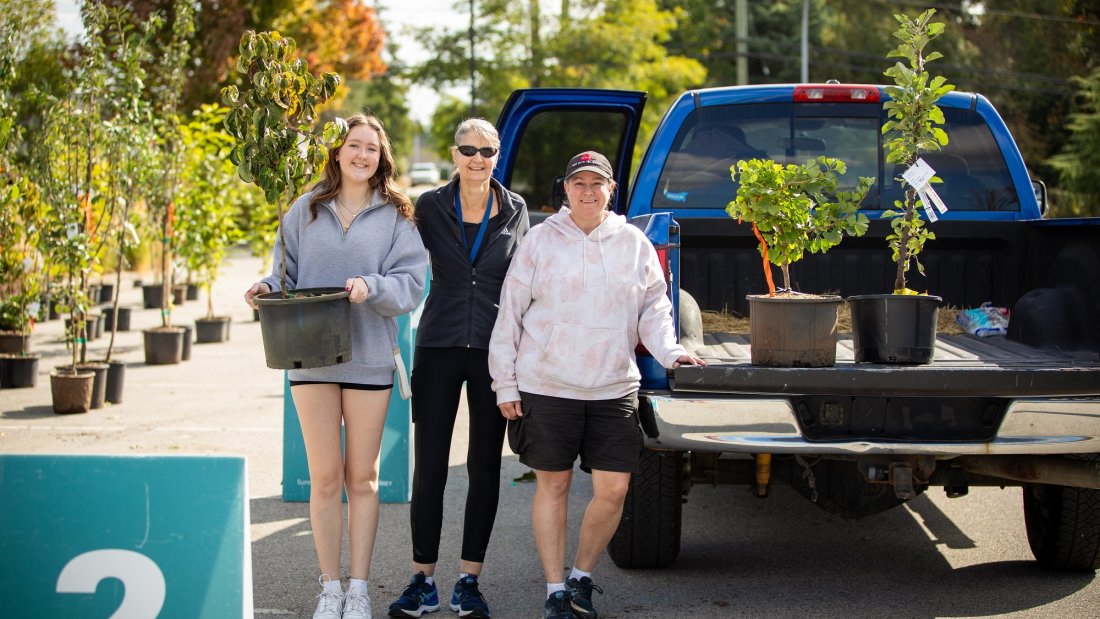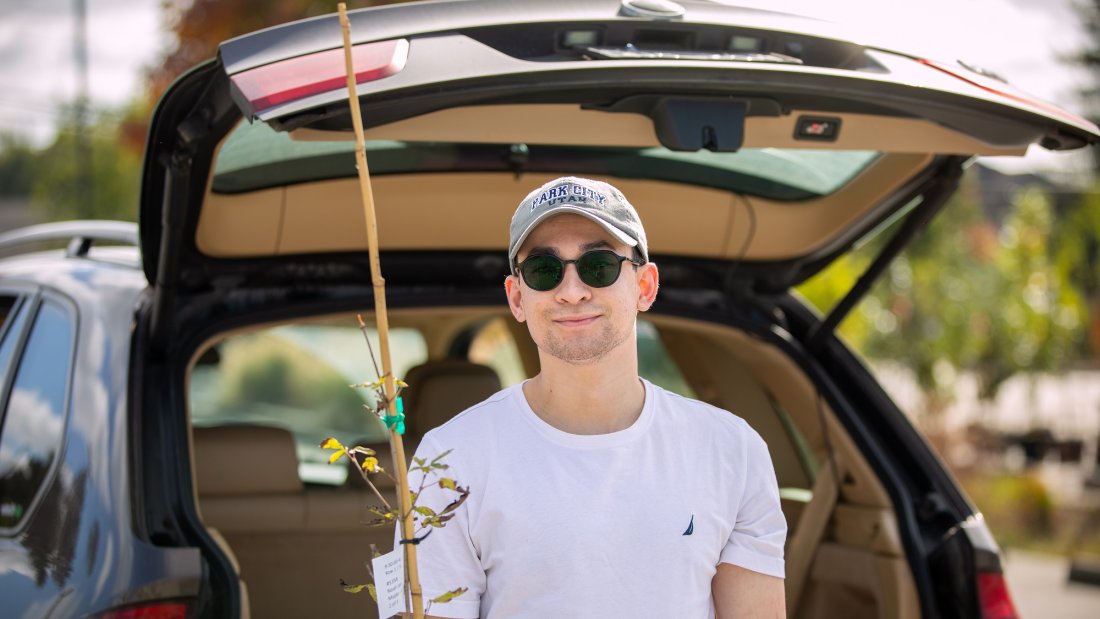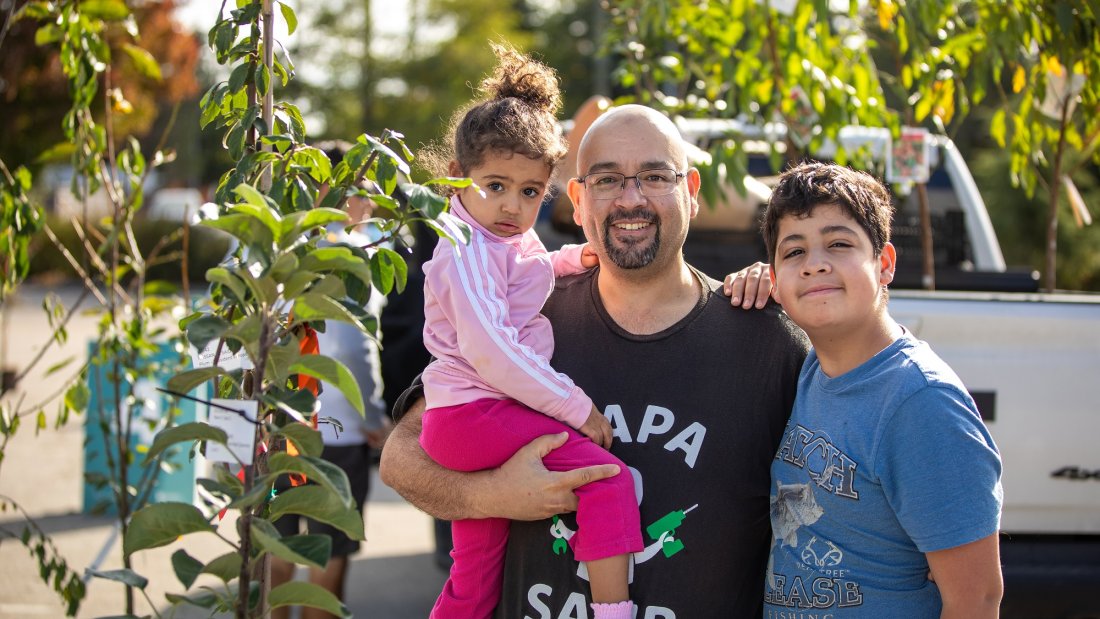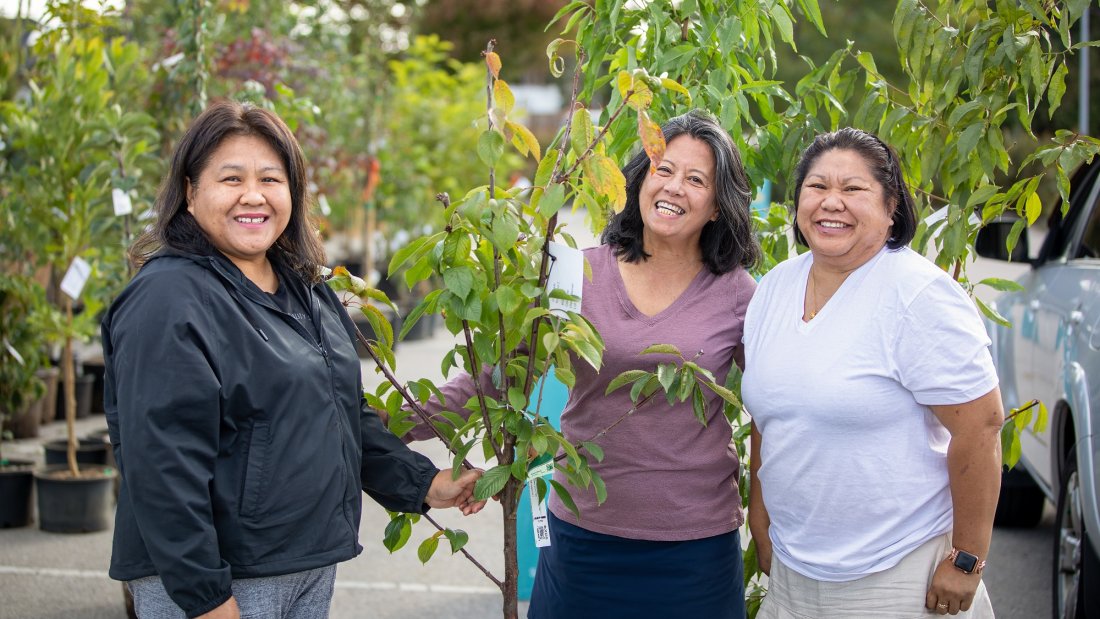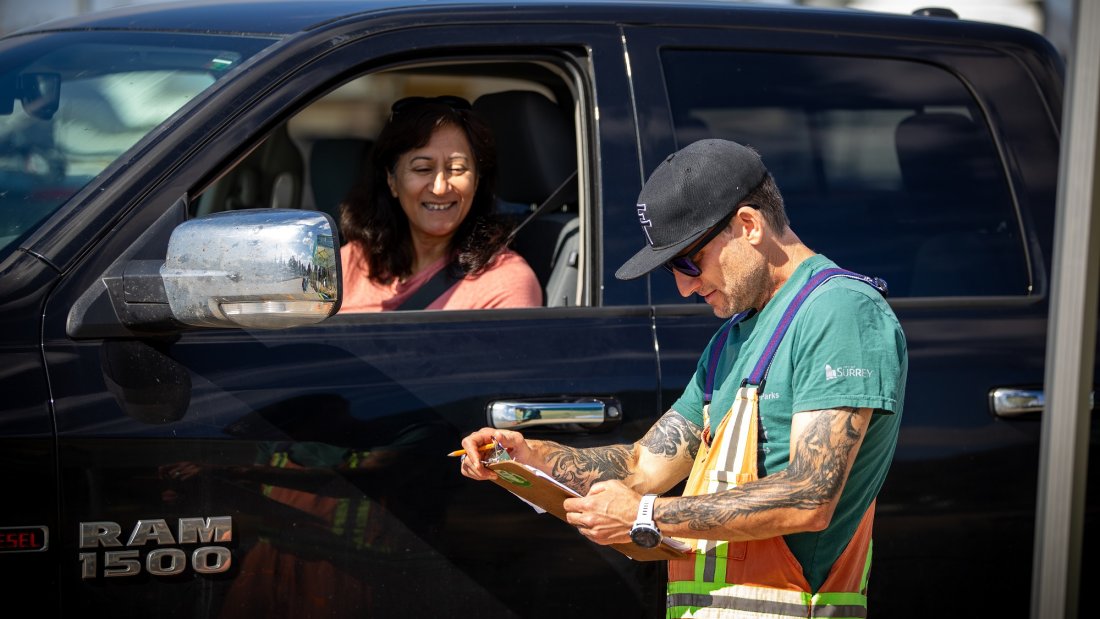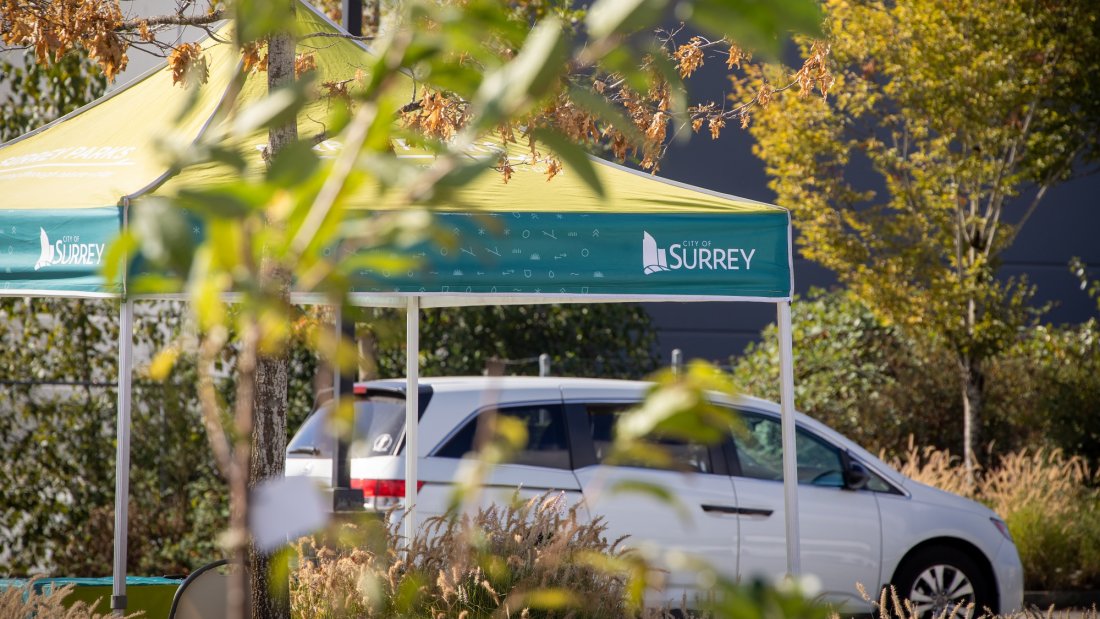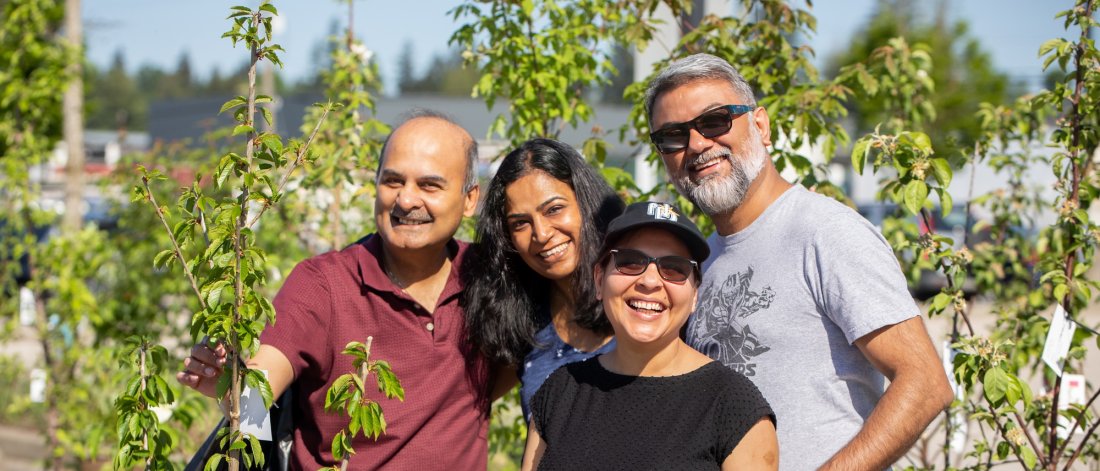
Tree Sale Program
Surrey residents can buy quality trees at an affordable price to help grow the urban forest.
Surrey Parks is hosting four tree sales in 2024. Future sale dates will be posted on this page, through social media, and our news and updates program.
New trees planted on your property:
- provide shade and insulation for your home
- increase your property value
- make your neighbourhood more livable
- help grow the urban forest by increasing tree canopy coverage
Purchases are made online and then later picked up from the Surrey Operations Centre.
Upcoming dates
August 21, 2024
Online store opens August 21 at 9am until September 4 (while supplies last). Tree pickup takes place Sunday, September 15.
September 25, 2024
Online store opens September 25 at 9am until October 9 (while supplies last). Tree pickup takes place Sunday, October 20.
Tree pickup location is at the Surrey Operations Centre (6651 148 Street).
Eligibility & limits
- This program is for private properties in Surrey.
- Trees are only available to Surrey residents.
- Trees must be purchased using a credit card with a Surrey billing name and address. Purchases made with billing addresses outside of Surrey will be cancelled.
- Maximum three trees per Surrey address, based on your billing address. Additional orders using the same billing address will be cancelled.
How to buy
All trees are $20. Most trees are in 3- or 5-gallon pots and vary between 5 to 12 feet tall. Ensure your vehicle can accommodate this.
Most trees average 2 to 3 cm caliper size, and would not meet the size requirements as replacement trees. We’re unable to guarantee the size of specific trees in advance of purchase.
When sales open:
-
Ensure you meet all eligibility requirements (see above).
-
Select up to three trees.
-
Proceed to your cart and choose your pickup time. Items in your cart are not held until payment has been processed.
-
Add a note in the text box if someone else will be picking up your trees on your behalf. Limits apply.
- Enter your payment details using a card with a Surrey billing name and address and check out.
You will receive a confirmation email of your order as well as a reminder prior to the pickup date at the Surrey Operations Centre (6651 148 Street).
Trees are considered final sale after pickup.
Tree list
Tree varieties for the August sale are listed below.
Each sale has approximately 1000 trees available for purchase. Trees are sold on a first-come, first-served basis.
Photos may not depict exact variety.
Apple
Ambrosia
Small tree, grows between 10-14 feet. Fruit is sweet and tender. Produces beautiful spring flowers.
Photo & info credit: NetPS Plant Finder
Braeburn (Semi-dwarf)
Small tree that thrives in full sun and well-drained soil, capable of reaching a height and spread of 15-20 feet. Clusters of pinkish-white flowers in spring and large, sweet-tart apples in fall, ideal for fresh eating and cooking.
Photo & info credit: NetPS Plant Finder
Treasured Red
Standing up to 16 feet with a width of 3-4 feet, this hardy columnar tree produces large, cherry-red apples ripening in early fall. The fruit, with its crisp, ivory flesh reminiscent of a McIntosh apple, is perfect for storing, baking, or enjoying fresh.
Photo & info credit: Canadian Tree Nursery
Beech
Dawych Gold
Accent tree known for its upright, columnar shape, smooth silver bark, and early golden leaves that turn vibrant green. Thrives in full sun, adapts well to various soil types, and requires significant moisture. Can grow up to 45 feet tall and 15 feet wide.
Photo & info credit: NetPS Plant Finder
Dawych Purple
Tall, columnar tree that can reach 60 feet in height and a spread of 20 feet. Its striking purple leaves turn coppery bronze in spring and fall. Thrives in full sun, adapts well to various soil types, and requires significant moisture. Perfect for adding height and color as an accent or shade tree.
Photo & info credit: NetPS Plant Finder
Cherry
Carmine Jewel
Small tree that produces crimson round fruit with hints of deep purple and red flesh. Showy white flowers in spring. Will typically grow to about 12 feet in height with a spread of 7 feet. Low canopy with a clearance of 3 feet from the ground. This is a self-pollinating variety.
Photo & info credit: NetPS Plant Finder
Juliet
Compact shrub that grows to a height of 8 feet and spread of 4 feet. Produces dark red sweet fruit, perfect for eating fresh and culinary uses. With fragrant spring flowers and attractive yellow leaves in fall, this shrub also attracts birds. Grows best in full sunlight.
Photo & info credit NetPS Plant Finder
Dogwood
Satomi
Multi-stemmed deciduous tree with showy clusters of pink flowers in late spring. Bluish-green leaves turn red in the fall. Great choice for attracting birds. Grows well in both full sun and full shade but prefers rich, acidic soils and an even amount of moisture. Grows to a height and spread of 25 feet.
Photo & info credit: NetPS Plant Finder
Starlight
Growing to 30 feet in height and 20 feet wide, Starlight boasts beautiful large white blooms in spring and lush green foliage that turns a brilliant red in the fall. Grows best in both full sun to partial shade but prefers rich, acidic soils and an even amount of moisture. Great for accent or shade.

Photo & info credit: NetPS Plant Finder
Venus
A fabulous hybrid covered with huge white blooms in spring, and leaves that change to a rich red in the fall; vigorous grower with an erect habit and slightly pendulous branches makes it a great choice for a front yard accent tree. Grows to a height and spread of 20 feet.
Photo & info credit: NetPS Plant Finder
Fig
Brown Turkey
Small tree, grows to 20 feet. An attractive deciduous garden tree producing exceptional, tasty, brownish purple fruits with pink-amber flesh that ripen in early summer; attracts birds; needs hot exposure to ripen fruit in cooler areas
These trees typically come in 2.5 gallon pots.
Photo & info credit: NetPS Plant Finder
Desert King
Large shrub commonly grown for its edible qualities, although it does have ornamental merits as well. It produces lime green fruit with a yellow blush and red flesh. It has attractive dark green foliage with chartreuse veins on a plant with a round habit of growth. Grows to be about 10 feet tall and wide. Does best in full sun to partial shade.
Photo & info credit: NetPS Plant Finder
Gingko
Columnar
The Gingko is characterized by its columnar form and fan-shaped leaves that turn bright yellow in fall. This vertical accent tree can reach 50 feet in height and a spread of 25 feet. It thrives in full sun and adapts to different soil and moisture conditions.
Photo & info credit: NetPS Plant Finder
Mariken (Dwarf)
This is a multi-stemmed deciduous shrub with a rough round form. This is a dwarf ginkgo tree with distinct fan-shaped leaves. Height reaches 24 inches, with a spread of 30 inches.
Photo & info credit: NetPS Plant Finder
Magnolia
Coates
A compact multi-stemmed deciduous tree with white and pink cup-shaped in the spring. Its habit is upright and round. Grows to a height of 20 feet and spread of 15 feet. Grows best in full sun to partial shade and prefers well-drained soil.
Photo & info credit: NetPS Plant Finder
Daybreak
A columnar deciduous tree with large, pink cup-shaped flowers. Very fragrant. Leaves turn coppery-bronze in the fall. Grows to a height of 30 feet and spread of 10 feet. Grows best in full to partial shade and prefers well-drained soli.
Photo & info credit: NetPS Plant Finder
Jane
Jane Magnolia has large tulip-shaped flowers. Blooms can reach 8 inches across when fully open. The closed flower is burgundy-purple with white on the inside. After the flower has been fully opened for a while, the colour of the outer side of the petals fades to pink. Grows 10 to 15 feet tall.
Info credit: Art’s Nursery
Sun Sprite
Highly columnar, tree is perfect for the modern compact garden. The 8-inch light yellow flowers with rose striping emerge only after the early frosts have gone. Fragrant and hardy. Mature height to 30 feet.
Photo & info credit: Reimer's Nursery
Maple
Japanese Elegans
An accent tree with a compact size, reaching 10 feet tall and 8 feet wide. Thrives in full sun to partial shade. Its salmon-toned spring leaves transition to rich greens in summer and to vibrant shades of gold, orange, and red in autumn, making it ideal for small gardens seeking year-round ornamental beauty.
Photo & info credit: NetPS Plant Finder
Japanese Purple-leaf
A spectacular accent tree with deep purple, palm-shaped leaves that turn deep green-bronze in summer and red in the fall. Produces red flowers in mid-spring and has an ornamental globe-shaped form. Ideal for full sun and partially shaded areas. Reaches a height and spread of 20 feet.
Photo & info credit: NetPS Plant Finder
Pear
Anjou
Larger tree, can grow to 45 feet. Produces high quality firm green pears, well known for fresh eating, cooking, and baking. Enjoy white flowers in early spring.

Photo & info credit: NetPS Plant Finder
Other
Seven-son Flower
This uncommon, multi-stemmed tall shrub has lime green leaves in spring, creamy white flowers in late summer, attractive pink fruits in the fall and shaggy red bark. With its open, upright-sprawling growth habit, it can grow up to 15 feet with a 12-foot spread. It’s relatively low maintenance but benefits from regular pruning. A great choice for attracting butterflies.

Photo & info credit: NetPS Plant Finder
Sweetgum–Slender Silhouette
A narrow columnar tree that reaches a height of 50 feet with a 10-foot spread. It features orange, yellow, and red leaves in the fall. Thrives in full sun and rich, acidic soils, perfect for accentuating gardens or creating shaded areas.

Photo & info credit: NetPS Plant Finder
Tree care
Learn more from the International Society of Arboriculture on planting a tree in your backyard and remember to water your trees regularly to keep them growing and healthy.
Questions
For help placing your order, call 604-501-5050.
For general inquiries, cancellations and refunds, email stewardship@surrey.ca. Include your order number if you have one.








